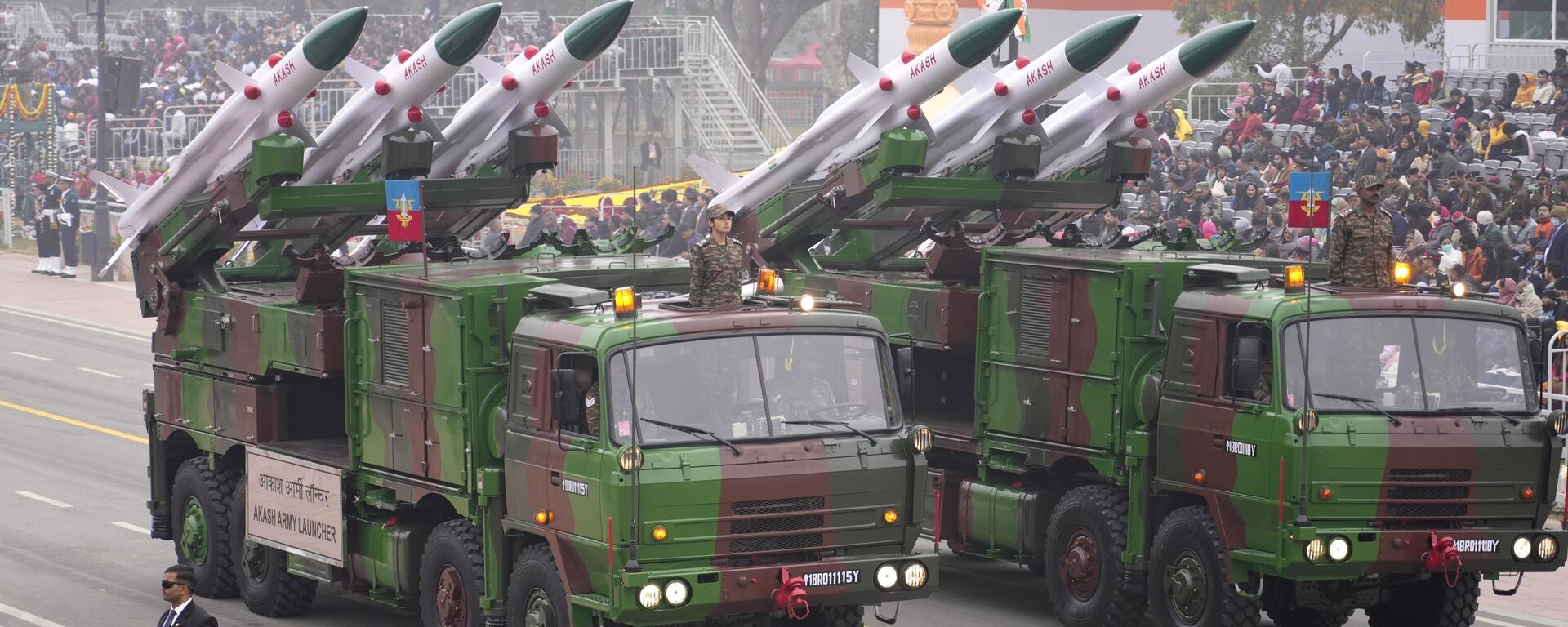https://sputniknews.in/20240402/lessons-from-ukraine-conflict-helped-india-develop-akash-missile-7013258.html
Lessons from Ukraine Conflict Helped India Develop Akash Missile
Lessons from Ukraine Conflict Helped India Develop Akash Missile
Sputnik India
India seems to be on a bolstering spree as far as its missile technology is concerned with the South Asian nation conducting another test of its medium-range projectile Akash during the weekend. Sputnik India examines what the development means for the Indian Army.
2024-04-02T17:18+0530
2024-04-02T17:18+0530
2024-04-02T17:18+0530
sputnik opinion
india
ukraine
russia
indian air force (iaf)
akash missile
missiles
short-range missiles
drdo
indian army
https://cdn1.img.sputniknews.in/img/07e7/0c/15/5921022_0:49:3471:2001_1920x0_80_0_0_094eb207f102be72dec939355ca01096.jpg
The Indian Army's Western Command carried out a successful test firing of the indigenous Akash missile – boosting both the capabilities of the Indian ground forces as well as the government's Atmanirbhar initiative."DRDO congratulates the Air Defence Warriors of Western Command the 'Sky Gladiators' for exhibiting high degree of professionalism. Indigenous Akash weapon system proving the capability time and again, a boost to Atmanirbhar Bharat," the Defence Research and Development Organisation (DRDO) said in a statement on Sunday.According to defense commentator and former Indian Air Force (IAF) pilot Vijainder K Thakur, the Indian Army tested the Akash 1S missile, the new version of the Akash 1 missile, which has an active seeker, making it more capable than the earlier variant of the short-range missile.The active seeker allows long-range engagements to be more deadly, Thakur underlined.Software Control Elevates Akash Missile to Premier Weapon StatusBut most of all, since it is an indigenous weapon system, its software is totally under the control of the DRDO and that's why it will be possible for the Army to detect weaknesses in the system and tweak the software to remove the weaknesses.Thakur stressed that one can understand this with what's happening in the ongoing military conflict between Russia and Ukraine.So that is the biggest capability boost India will get because it never had indigenous weapons systems.For example, if you have a French missile, and suddenly the Chinese introduce a weapons system with different ballistics or flight profiles that can outwit your missile system, you must wait for the French to come and assist you in winning the war. Another question would be whether they will be ready to help in this scenario or how much they will charge for their services.India's Latest Family of MissilesMoreover, Akash is not being developed as a single missile. It has now become a family of missiles, having three variants.He revealed that the initial version of the missile did not have an active seeker and was first inducted into the IAF. Subsequently, the Akash introduced an active seeker into its fold, transforming it into a far more potent rocket.On the other hand, the Akash-NG, which is totally a new variant of the missile, has a dual pulse motor.
https://sputniknews.in/20231221/whats-behind-rising-foreign-interest-in-indias-akash-missile-5912917.html
india
ukraine
russia
Sputnik India
feedback.hindi@sputniknews.com
+74956456601
MIA „Rossiya Segodnya“
2024
Pawan Atri
https://cdn1.img.sputniknews.in/img/07e6/0c/13/139630_147:0:831:684_100x100_80_0_0_8fa2b25903e7787fe6a2698552c167df.png
Pawan Atri
https://cdn1.img.sputniknews.in/img/07e6/0c/13/139630_147:0:831:684_100x100_80_0_0_8fa2b25903e7787fe6a2698552c167df.png
News
en_IN
Sputnik India
feedback.hindi@sputniknews.com
+74956456601
MIA „Rossiya Segodnya“
Lessons from Ukraine Conflict Helped India Develop Akash Missile
Sputnik India
Lessons from Ukraine Conflict Helped India Develop Akash Missile
2024-04-02T17:18+0530
true
PT0M45S
Sputnik India
feedback.hindi@sputniknews.com
+74956456601
MIA „Rossiya Segodnya“
Pawan Atri
https://cdn1.img.sputniknews.in/img/07e6/0c/13/139630_147:0:831:684_100x100_80_0_0_8fa2b25903e7787fe6a2698552c167df.png
akash missile, indian army western command, drdo, flight-test, new generation akash, akash-ng, interceptor missile, integrated test range, chandipur, odisha, 4th test, unmanned aerial target, weapon system, radio frequency seeker, launcher, multi-function radar, command, control & communication system, akash ad (air defence) system, soviet era sa-6, nato codename gainful, ramjet propulsion, tvm (track via missile) seeker, sarh (semi active radar homing), command guidance, dual pulse rocket motor, active seeker, jamming, spoofing, indian air force, low rcs, mobility, field storage, wheeled vehicle/trailer, missile canisters, electropneumatics and hydraulics (india) pvt ltd (ehpl), bharat electronics limited (bel), multiple targets, intercept range, active homing, fire and forget, elevation, azimuth, reloading time, reaction time, target acquisition, firing rate, transportation mode, electronic target, hard manoeuvring target, transporter erector & launcher (tel), control cabin, power generation, user trials, russia's special military operation (smo), ukraine, military operation, drones, ad missiles, local production, akash ad system, armed forces,
akash missile, indian army western command, drdo, flight-test, new generation akash, akash-ng, interceptor missile, integrated test range, chandipur, odisha, 4th test, unmanned aerial target, weapon system, radio frequency seeker, launcher, multi-function radar, command, control & communication system, akash ad (air defence) system, soviet era sa-6, nato codename gainful, ramjet propulsion, tvm (track via missile) seeker, sarh (semi active radar homing), command guidance, dual pulse rocket motor, active seeker, jamming, spoofing, indian air force, low rcs, mobility, field storage, wheeled vehicle/trailer, missile canisters, electropneumatics and hydraulics (india) pvt ltd (ehpl), bharat electronics limited (bel), multiple targets, intercept range, active homing, fire and forget, elevation, azimuth, reloading time, reaction time, target acquisition, firing rate, transportation mode, electronic target, hard manoeuvring target, transporter erector & launcher (tel), control cabin, power generation, user trials, russia's special military operation (smo), ukraine, military operation, drones, ad missiles, local production, akash ad system, armed forces,
Lessons from Ukraine Conflict Helped India Develop Akash Missile
India seems to be on a bolstering spree as far as its missile technology is concerned with the South Asian nation conducting another test of its medium-range projectile Akash during the weekend. Sputnik India examines what the development means for the Indian Army.
The Indian Army's Western Command carried out a successful test firing of the indigenous Akash missile – boosting both the capabilities of the Indian ground forces as well as the government's Atmanirbhar initiative.
"DRDO congratulates the Air Defence Warriors of Western Command the 'Sky Gladiators' for exhibiting high degree of professionalism. Indigenous Akash weapon system proving the capability time and again, a
boost to Atmanirbhar Bharat," the Defence Research and Development Organisation (DRDO) said in a statement on Sunday.
According to defense commentator and former Indian Air Force (IAF) pilot Vijainder K Thakur, the Indian Army tested the Akash 1S missile, the new version of the Akash 1 missile, which has an active seeker, making it more capable than the earlier variant of the short-range missile.
The active seeker allows long-range engagements to be more deadly, Thakur underlined.
"It is being honed to the operational requirements of the Army – so it has got adequate mobility, unlike the Indian Air Force (IAF) version of the missile, which is an older version that doesn't have the kind of mobility that the Army variant has. Therefore, undoubtedly, it will give the Indian Army much better capability in air defense, especially for formations on the move," the defense pundit told Sputnik India on Tuesday.
Software Control Elevates Akash Missile to Premier Weapon Status
But most of all, since it is an indigenous weapon system, its software is totally under the control of the DRDO and that's why it will be possible for the Army to detect weaknesses in the system and tweak the software to remove the weaknesses.
Thakur stressed that one can understand this with what's happening
in the ongoing military conflict between Russia and Ukraine.
"Every time Ukraine deploys a new weapon like the STORM Shadow missile or the Army Tactical Missile System (ATACMS), the Russians are able to tweak the software - study the flight characteristics of either the missile or the shell that is being fired and quickly modify the software algorithm to optimize the missile for interception of such targets," the retired military officer explained.
So that is the biggest capability boost India will get because it never had indigenous weapons systems.
For example, if you have a French missile, and suddenly the Chinese introduce a weapons system with different ballistics or flight profiles that can outwit your missile system, you must wait for the French to come and assist you in winning the war. Another question would be whether they will be ready to help in this scenario or how much they will charge for their services.
"Like what happened during the Kargil War, the French charged an atrocious amount of money for giving India the laser-guided munition capability. That way, it is a huge capability boost because now India is sure that it has a missile that functions exceptionally well," Thakur observed.
India's Latest Family of Missiles
Moreover, Akash is not being developed as a single missile. It has now become a family of missiles, having three variants.
He revealed that the initial version of the missile did not have an active seeker and was first inducted into the IAF. Subsequently, the Akash introduced an active seeker into its fold, transforming it into a
far more potent rocket.
On the other hand, the Akash-NG, which is totally a new variant of the missile, has a dual pulse motor.
"In this, what happens is that when the missile is launched, it is accelerated by one motor and then the motor switches off before moving toward its target. As it approaches the target, the second motor lights up and this dual pulse motor allows the missile to gain the power to maneuver sharply, making it extremely difficult for the enemy to escape from it," Thakur concluded.




